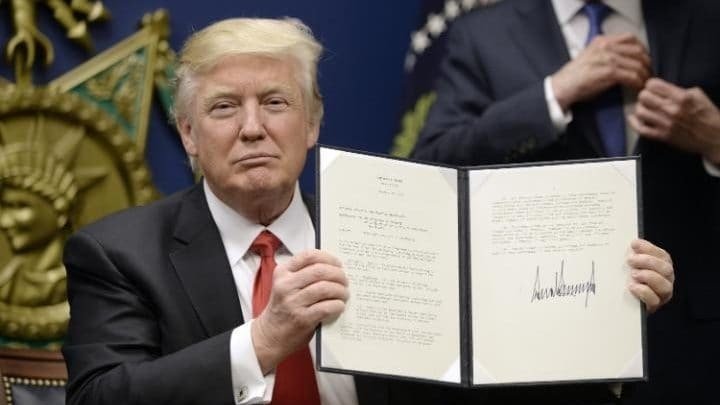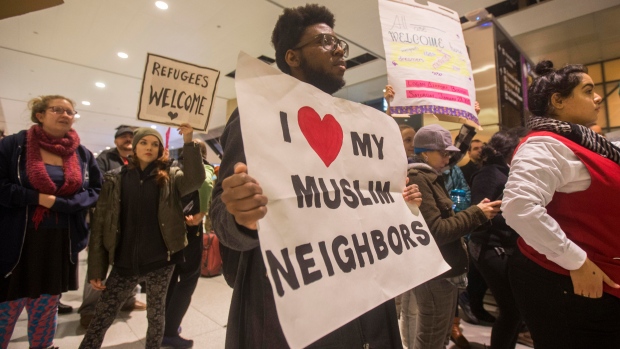
The Supreme Court Monday (June 25) allowed parts of President Donald Trump’s controversial Muslim ban to go into effect and will hear oral arguments on the case this fall.
The apex Court ruled that despite rulings in two different federal courts – that the ban should be put on hold while judges decide whether it’s constitutional – the Trump administration should be allowed to enforce the ban starting on Thursday, June 29, 72 hours after the court’s ruling was issued.
However, people from the six countries listed in President Trump’s travel ban ― Libya, Iran, Somalia, Sudan, Syria, Sudan, Yemen ― can travel to the U.S. if they possess a “bona fide” relationship with the U.S.
It is believed that the vast majority of people who would be coming to the U.S. from these countries can easily prove that relationship. Neither refugees being resettled in the U.S. nor visa holders will be impacted.
President Trump hails Supreme Court decision
President Donald Trump was quick to celebrate the Supreme Court verdict by saying that the court’s unanimous decision was “a clear victory for our national security”.
“It allows the travel suspension for the six terror-prone countries and the refugee suspension to become largely effective,” he said in a statement.
“As President, I cannot allow people into our country who want to do us harm. I want people who can love the United States and all of its citizens, and who will be hardworking and productive.
“My number one responsibility as Commander in Chief is to keep the American people safe. Today’s ruling allows me to use an important tool for protecting our Nation’s homeland. I am also particularly gratified that the Supreme Court’s decision was 9-0.”
American Civil Liberties Union
Shortly after the court issued its opinion, the American Civil Liberties Union (ACLU) said on Twitter it would “head back into court to fight the fundamentally unconstitutional Muslim ban this October”.
Omar Jadwat, the director of the ACLU’s Immigrants’ Rights Project who had argued the case in court, said in a statement the travel ban “violates the fundamental constitutional principle that government cannot favor or disfavor any one religion”. “Courts have repeatedly blocked this indefensible and discriminatory ban. The Supreme Court now has a chance to permanently strike it down,” he said.
Lara Finkbeiner, from the International Refugee Assistance Project, which also sued the administration over the ban, said she was “incredibly disappointed with the decision”. “We are a nation that values acceptance and diversity, and in making this decision and putting this executive order back into effect, the Supreme Court is sending a very clear message and it’s putting the executive’s discriminatory policy back into effect.”
The Council on American-Islamic Relations, the country’s largest Muslim civil rights and advocacy organisation, said the decision “ignores the Islamophobic origins of the policy” and emboldened Islamophobes in the Trump administration. “It also ignores the almost-unanimous rejection of the Muslim ban by lower courts due to its religious intolerance and racial animus,” said Nihad Awad, the group’s national executive director.
Both sides declared victory on the travel ban
Writing under the title “Both sides declared victory on travel ban” the Mother Jones said in different ways, both sides are right. It went to say:
“In one of the most contentious and important battles of the Trump presidency to date, the Supreme Court may have found a way to appease both sides without handing a full victory to either. For Trump, who manages to spin even the most dubious outcomes as big wins, Monday’s order may have given him plenty of fodder—after all, a ban with exceptions is still more of a success than Trump’s gotten from the lower courts, which have universally ruled against him. For the ban’s opponents, the narrowness of the ban that will go into effect could also constitute a win. Finally, the court set up the case such that it may never ultimately issue a final ruling—allowing the ban’s critics to declare a substantive victory over the administration but sparing the president what would likely be an embarrassing loss this fall.”
For Los Angeles Times, the Supreme Court on Monday took a pragmatic approach to resolving the dispute over President Trump’s foreign travel ban with a middle-ground ruling that may defuse the controversy — for now.
“The decision allowed much of the ban to take effect, but it also applied significant restrictions that will narrow the order’s impact. In a short, unsigned but unanimous opinion, the justices avoided taking a stance on the larger constitutional questions concerning religious discrimination or presidential authority, the LA Times said adding:
“But they also largely rejected the lower court rulings that had blocked Trump’s order as unconstitutional, handing a partial victory to the president and his lawyers after a string of rebukes in federal courts from Hawaii to Maryland. The justices also strongly hinted that they may never need to settle the larger constitutional issues because the case could be moot by the time they hear it in the fall.”
The Supreme Court ruling was unsigned
The ruling was unsigned, with 6 justices — the court’s four liberal justices (Ruth Bader Ginsburg, Stephen Breyer, Sonia Sotomayor, and Elena Kagan) joined Justice Anthony Kennedy and Chief Justice John Roberts in partially lifting the hold on the ban, while conservative justices Neil Gorsuch, Clarence Thomas and Samuel Alito argued that the Trump administration should be allowed to enforce the ban in all cases. Justices Neil Gorsuch was appointed by President Trump in April this year.
In a dissenting opinion, Justice Clarence Thomas warned that requiring officials to differentiate between foreigners who have connection to the US and those who do not will prove “unworkable”. “Today’s compromise will burden executive officials with the task of deciding – on peril of contempt – whether individuals from the six affected nations who wish to enter the United States have a sufficient connection to a person or entity in this country”. He added that the decision would result in a “flood of litigation” until the court issued its ruling.
The court’s order released Monday said a “close familial relationship is required” for individuals who wish to live with or visit a family member. When the relationship is with an entity like a university, it must be “formal, documented, and formed in the ordinary course, rather than for the purpose of evading” the executive order.
As an example, they said, students and lecturers would have a formal relationship, as would someone who accepted employment with an American company. But it would not apply to someone who “enters into a relationship simply to avoid” the executive order. For example, the order said, “a nonprofit group devoted to immigration issues may not contact foreign nationals from the designated countries, add them to client lists, and then secure their entry by claiming injury from their exclusion.”
The court’s opinion noted the government is free to work on the new vetting procedures for immigrants from the six countries. This was the ostensible purpose of the order in the first place.
“We fully expect that the relief we grant today will permit the executive to conclude its internal work and provide adequate notice to foreign governments within the 90-day life of Sec. 2c,” the court said, referring to the key clause in the travel ban order.
How experts interpret the verdict?
Margo Schlanger, a professor of law at the University of Michigan, who also headed the civil rights and civil liberties division at the Department of Homeland Security under Barack Obama from 2010-11, said the supreme court had actually paved the way for the bulk of travelers affected by the ban to come into the US.
“In reality, the travel ban remains largely enjoined,” Schlanger said. “If [travelers] didn’t have a real connection – a job, or enrollment at a school, or a family member – they wouldn’t be able to get visas. Most of the travel that’s covered by the travel ban remains stayed,” she added. “I think the Trump administration is spinning,” Schlanger was quoted by the Guardian as saying.
Schlanger acknowledged that the supreme court’s ruling did not represent a “home run” for the plaintiffs, since the court had not chosen to simply uphold the injunctions by district courts in both Hawaii and Maryland that had previously blocked the Trump administration from enforcing either the travel or refugee ban at all.
“I think it’s a vast exaggeration to say this is a victory for the president,” Jennifer Gordon, a professor of law at Fordham University who focuses on immigration was quoted as saying.
Noting that at least five justices agreed on the need to grant visas to individuals with a “credible claim of a bona fide relationship with a person or entity in the United States”, Gordon argued that the court’s decision reflected a seemingly majority consensus that the Trump administration could not implement an outright ban on immigrants from the six-Muslim countries.
“In fact, you might read it as a signal … that the president might well lose on this,” she said.
In essence, the court agreed to hear oral arguments on the merits of the executive order. At least three conservative justices on the bench – Clarence Thomas, Samuel Alito, and Neil Gorsuch – would have preferred to have allowed the travel ban to go into full effect, but ultimately the court significantly narrowed the scope of Trump’s order.
Trump’s controversial Muslim Ban orders
President Trump first signed an executive order on this issue in January 27, a week after he became President. In addition to the scenes of chaos at airports, the signing of the order also triggered widespread protests from those opposed to Mr Trump’s actions. Several courts said the ban was unconstitutional and put it on hold.
The President then signed a second order in early March that excluded Iraq from the list of countries.
During the 2016 presidential race, Trump campaigned for “a total and complete shutdown” of Muslims entering the United States. The travel ban was a signature policy of Trump’s first few months as president.
Last month, the 4th Circuit Court of Appeals in Virginia upheld a district judge in Maryland who blocked Trump’s order. The appeals court, in a 10-3 decision, said the executive order reflected an unconstitutional discrimination based on religion. Its opinion cited Trump’s campaign pledge to enact a “Muslim ban.”
Shortly afterward, the 9th Circuit Court in California upheld a district judge in Hawaii and ruled Trump’s order was illegal because the president did not demonstrate a threat to national security.
Hawaii Attorney General Douglas Chin, who successfully challenged the ban in lower courts, said that students from affected countries due to attend the University of Hawaii would still be able to do so.
Top Democrats voiced concern that the court had enabled Trump to at least partially see through his pledge to ban both Muslims and Syrian refugees from the US. “The Trump Administration has consistently shown that discrimination, not national security, is the purpose of this ban,” said Nancy Pelosi, the House Democratic leader. “The Supreme Court’s move to largely lift the injunctions against the open prejudice of the Muslim and refugee ban sends the wrong message to our partners on the front lines of the fight against terror,” she added. “We hope that the Court will ultimately come to the only conclusion consistent with our values, our national defense and the Constitution.”
Abus Sattar Ghazali, the Chief Editor of the Journal of America (www.jurnalofamerica.net) email: asghazali2011 (@) gmail.com












































